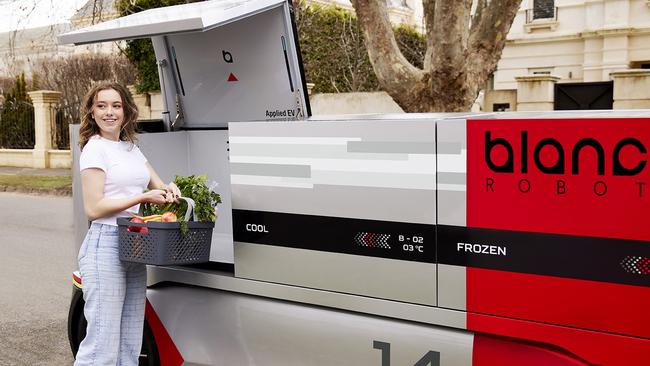Why autonomous vehicle maker Applied EV isn’t interested in the ‘robotaxi trap’
An Aussie self-driving vehicle start-up, led by a former GM veteran, has big plans for its technology but ferrying passengers is not in the plans. Here’s why.

One of the few Australian start-ups to dabble in autonomous vehicles has pretty clear plans for the kind of product it wants to make – and it’s a long way from a robotaxi.
Applied EV chief executive Julian Broadbent is, in fact, hellbent on staying away from the sector altogether – believing there’s little money to be made in ferrying passengers around in an autonomous vehicle.
The former GM veteran of almost two decades, who led the automotive company’s global expansion, is instead gung ho on logistics which is an area he believes has a far better chance of bearing fruit.
He envisages delivering groceries and other items at all hours thanks to technology, without humans driving.
“It allows a whole lot of e-commerce opportunities,” he told The Australian.
“What it’ll mean is you’ll be able to do things at a very low cost, and so now that man with the van can become a concierge service.”
Applied EV has for the past few years been at work on what Mr Broadbent describes as a “software-defined” vehicle – technology that sits on top of a regular vehicle’s chassis to operate it autonomously.

The start-up, which has done deals with companies such as Suzuki and has funding from billionaire Trevor St Baker’s Baker Energy Innovation Fund, is also against reinventing the wheel, so to speak.
“Unlike some other companies, we’re using automakers to do vehicles at extremely low cost,” Mr Broadbent said.
“Nothing that we’re bringing to the market, despite a few subtleties in terms of the actual vehicle, is actually new. Some companies are trying to do a new mousetrap and what we’re really doing is pulling something off the production line that is already being built.”
Applied EV has signed two contracts with Suzuki – one for 100 and another for 400 vehicles.
The start-up is integrating its Blanc Bone, what it describes as the digital backbone of a vehicle, on top of the ladder frame of Suzuki’s 4WD Jimny.

“We’re accessing the economics as a partner of a 1.5 million manufacturing program at a very low margin with very strong pricing power, and we couldn’t do that if we were building it from scratch,” Mr Broadbent said.
Robotaxis are already dropping passengers off in cities in the US as part of major trials. In October, Google’s parent company, Alphabet, began operating autonomous vehicles in Los Angeles via its subsidiary, Waymo.
Mr Broadbent said Australia was still years away from any such service, and even if the company was allowed, Applied EV would not compete in that market.
“We’re actively avoiding the robotaxi trap. We really like the cost reduction of no interiors and no cabin and we think with robotaxis there are other challenges to clean cars in a very different way,” he said.
“There’s a lot of human passion about it but I don’t think it’s a great business. I think the logistics business is much bigger than taxi businesses around the world.”

The cost of building an autonomous vehicle has dropped significantly, and Applied EV is able to make an autonomous vehicle for between $50,000 to $100,000, Mr Broadbent said.
Applied EV sees a future in which postage and delivery will be free, and logistics providers will be able to commercialise the use of autonomous fleets to provide on-the-go and on-demand changes to delivery and other e-commerce opportunities.
The company last month reached an agreement with NXP, which provides vehicle network processors for Applied EV’s Blanc Robot, to collaborate on research and further development of autonomous vehicles.





To join the conversation, please log in. Don't have an account? Register
Join the conversation, you are commenting as Logout